Hagia Sophia Istanbul- Is a church or is a mosque?
Hagia Sophia Istanbul (after conversion)
As promised before, here we are with the recent updates for Hagia Sophia Istanbul. Converting into the mosque or in other words, cancellation of the museum conversion was not surprising at all. This was simple to guess for ourselves and it was within our expectation.
In summary, you can see the chart below to understand what happened to Hagia Sophia Istanbul over the centuries starting from the beginning.

We will keep the sections considering the most up to date condition, but we will also refer to the old condition where necessary. And when you see “after conversion” on the title, this means that we have updated this section, and definitely worth looking at it for the info after conversion.
What changed after conversion in 2020? (after conversion)
- Since it is not a museum anymore, we should be careful about the dress code. It is not too complex, basically, you should cover your head, your upper body, your upper legs as a woman. As a man, it is less complex, at least your upper body (t-shirt is OK) and your legs up to the bottom of the knee cap should be covered.
- Nobody can charge you when entering a mosque. In the future, it may be considered for the upper gallery, but since the upper gallery is under restoration activities, this basically means there is no entrance fee or ticket price. Thus, the museum pass question is also not valid anymore for Hagia Sophia Istanbul.
- Ayasofya-i Kebir Camii-Serif is the new name of this splendid monument. Kebir means “Grand”. The reason behind this is every city has a grand mosque and Hagia Sophia is the Grand mosque of Istanbul.
- The base floor is covered with turquoise carpet. You may know that every mosque has a carpet for ease of cleaning and clean praying. This is the reason.
- You will also see automated curtains on several spots on the walls. They are covered during praying which is necessary.
- One thing will never change. Hagia Sophia will always be splendid. No matter it is a mosque, a museum, or a church.

Hagia Sophia Istanbul– Details (after conversion)
Hagia Sophia Istanbul… Standing for around 1500 years, still one of the most outstanding monuments of Istanbul and the world. Moreover, it has been used as a church and it has been used as a mosque for long periods. Mustafa Kemal Ataturk– the leader and the father of the Turkish people and the government decided that Hagia Sophia should have served as a museum after the Turkish Republic foundation.
Two questions were still famous about Hagia Sophia. “Will Hagia Sophia be a church again?” and “will Hagia Sophia be a mosque again?”. The conversion decision into the mosque in 2020 cleared all these questions.
More info is in the post about its history 😉
The cathedral was the main building of the Orthodox sect for 900 years before the Ottomans. This was the most impressive cathedral of these centuries. Considering the whole cathedrals in the world, Hagia Sophia is the fourth largest. After Constantinople’s conquest and conversion of the cathedral into the mosque, it was also one of the most impressive mosques of these centuries.
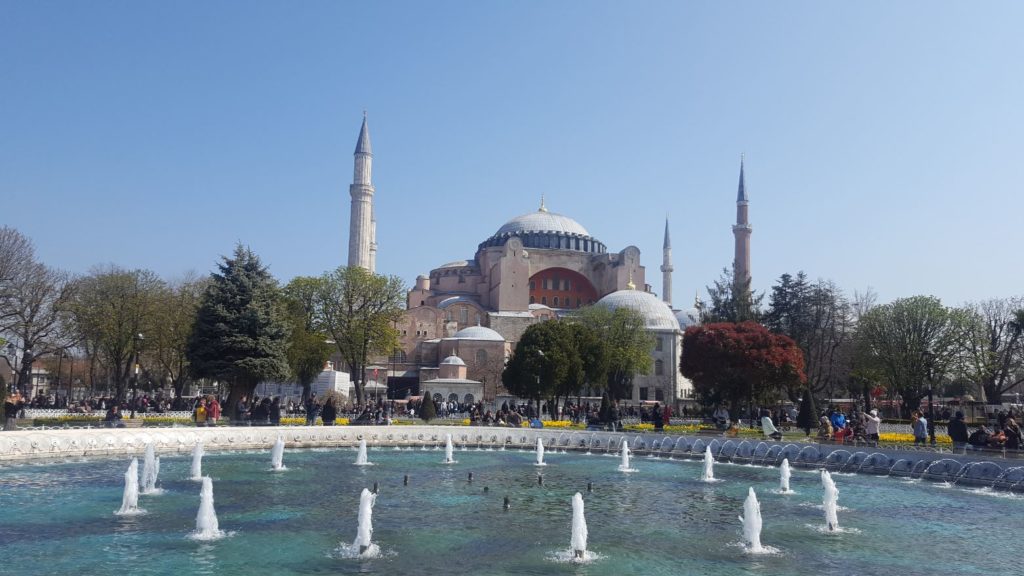
Can we Pray? (after conversion)
Please note that the Hagia Sophia is also important because of being part of the Unesco World Heritage site in Istanbul. Since it is a mosque, Muslims can pray in Hagia Sophia Istanbul.

Why is it so Famous?
Hagia Sophia is so famous because of some reasons.
- As architectural, the cathedral is amazing. Mosaic art is impressive.
- It is standing for around 1500 years. Even, Hagia Sophia Istanbul has been damaged by severe earthquakes [1] in previous centuries, it still looks powerful with performed necessary restorations.
- Serving to both Orthodox and Muslim. Converted into a mosque from a cathedral. This is very rare in the world.
Is it a Wonder of the World?
Hagia Sophia Istanbul is often called the eighth wonder of the world. It has been selected as one of the 21 finalists of the official seven wonders of the world competition. Unfortunately, it is not one of the seven wonders [2]. It doesn’t matter, it is still one of the finalists, so you can understand that this one is definitely a “must-see” place in Istanbul.
What does Hagia Sophia Mean?
Hagia Sophia, Ayasofya in Turkish, Latin Sancta Sophia means “holy wisdom”. The cathedral is also called the Church of the Holy Wisdom or Church of the Divine Wisdom. [3]
When and Why Hagia Sophia was Built?
Basically, the current standing Hagia Sophia was the third one in Constantinople [4]. Byzantine Empire performed all the efforts about construction before the Ottomans. Moreover, the empire repaired Hagia Sophia after re-capturing Constantinople from Romans in the 13th century because of the severe damages that happened in the Roman Empire period and during the Fourth Crusade by Venetians and the Crusaders.
Check out the Istanbul history in this post if you are more interested in [4].
The first structure was burned in 404 AC during the rebellions in Arkadios’ period because of some political conflicts. The first one was commissioned by Emperor Constantine I. Right after, emperor Theodosius re-constructed the Hagia Sophia with a little bit improved version of the first one. The first two buildings had a wooden roof. Again, Hagia Sophia was burned down during rebellions in the Justinian period. [5]
Justinian Period
So, here we start. Justinian I was very dedicated to having a more powerful basilica due to two collapses. Additionally, he also wanted a more splendid structure than King Solomon’s temple. He hired two architects- Isidoros and Anthemios from the Aegean region to construct the gigantic dome and other parts. Even it was started in 532, it is still an unclear question of how they completed Hagia Sophia in only five years with limited technology. It is an impressive effort, isn’t it? Furthermore, the cathedral has a world-record as the fastest constructed cathedral in the world. Based on some resources, it is stated that around or above 10,000 people worked on the construction [6].
Moreover, the columns have been brought from many locations such as Ephesus Artemis temple, Egypt sun temple, and Lebanon Baalbek temple. It is also an interesting question, “how did they carry such huge columns in a short period?”. Furthermore, the colorful stones and marbles came from Greece, Syria, and many locations in Anatolia.
After completion, according to some resources, Justinian entered the temple, and right after he said “My Lord, thank you for giving me chance to create such a worshipping place” and “Solomon, I beat you” compared with Solomon’s temple in Jerusalem. [7]
Due to having a huge dome and weight on itself, water cisterns have been used to support the building statically. However, the dome collapsed 20 years later. At this time, Justinian assigned Isidoros’ nephew and young architect used light stones to reduce the dome’s weight. The architect also raised the dome a little bit more. Moreover, some struts have been used to support the Hagia Sophia.
After Opening
Hagia Sophia Istanbul internal structure and mosaic handiwork continued thirty years after the first opening and completed in Justinian II. Moreover, some mosaics have been completed in the following centuries. In order to make this fantastic mosaic art, they used gold, silver, colored glass, and soil.
When did Hagia Sophia Become a Mosque? (after conversion)
It happened twice (the first one is from church to mosque in 1453 and the second one is from the museum to the mosque in 2020). The following paragraphs are about 1st conversion.
Hagia Sophia Istanbul became a mosque after Constantinople’s conquest by Sultan II. Mehmed- Fatih (the conqueror in English) Sultan Mehmed. Also, the Ottomans performed several repairs. They also added Mihrab showing the direction to Mecca and Minbar which is used by muezzins/imams during sermons. Furthermore, they constructed four minarets in different periods. Additionally, the famous architect Sinan supported the structure with some struts.
In the facility, the tombs of Sultans- Selim II, Mehmet III, Murat III, some of their relatives can be found. Sultan Mahmut I commissioned to construct a fountain. Also, primary school, soup kitchen, library, Sultan Abdulmecid’s meeting place are also in the territory. [8]
When did Hagia Sophia Become a Museum? (after conversion)
The Hagia Sophia Istanbul served as a mosque for 481 years. The Turkish Republic was founded in 1923 and twelve years later, it was decided to convert the mosque into a museum. Starting from 1931, a team from Harvard worked on removing plasters and they were responsible for uncovering the mosaic art. It served as a museum till 2020.
Hagia Sophia- What is Inside? (after conversion)
Here is the plan of the Hagia Sophia Istanbul before turning into the mosque. In the facility, there are tombs, fountain (
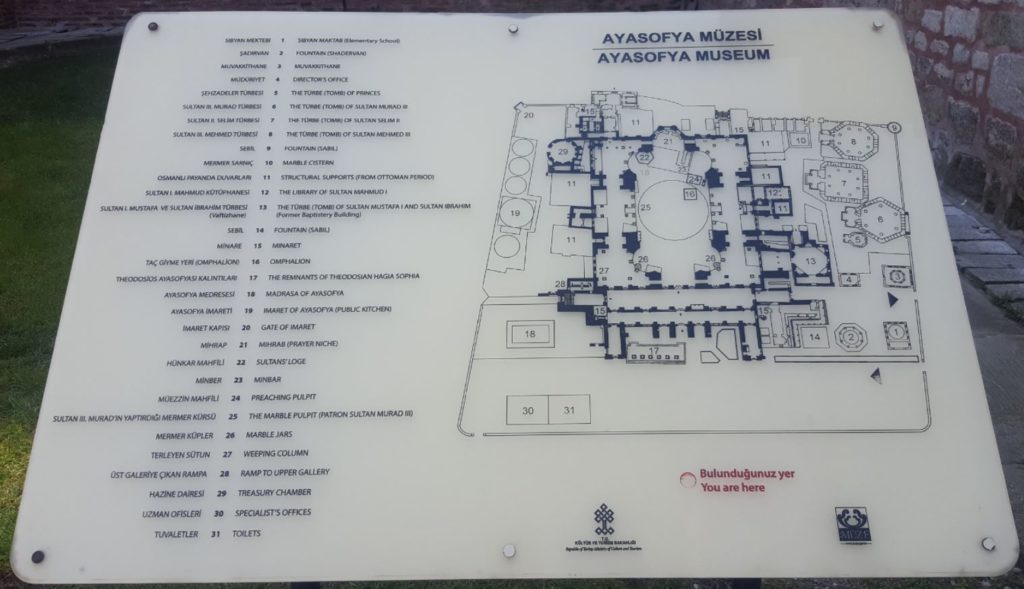
Base Floor
After going thru the Emperor Gate, there is a marble jar coming from the district Bergama- west of Turkey in Sultan III. Murad. Right after, you will definitely check the dome and what is around. See Mosaic Art section of the post where we cover mosaics and their meanings. Fatih Sultan Mehmed admired the art, so he didn’t want to remove the mosaics. They just covered them with plasters. You will also see Sultan’s lodge, muezzin’s lodge (imam), altar, and the library of Mahmud I on the base floor.

Panels that were hung on the columns contain the names of Allah, the prophet Muhammed, the first four Caliphs, and the Prophet’s two grandsons [5,8]. They were scaled from Kazasker Mustafa Izzet’s studies who was a famous Ottoman calligrapher. You will also the Mihrab and the Minbar which were added during the Ottoman period. There are also some tiles that were added during this period too.

On the northwest of the building, you will see a wishing/perspiring column. The column has a hole and the around of the hole is covered by bronze plates. There are some legends about this column. One of them is Justinian had severe headaches and when he put his head to this column, it was gone. So, people mostly believed that the hole had a healing effect. The other is the perspiring effect that comes from Virgin Mary’s tears.
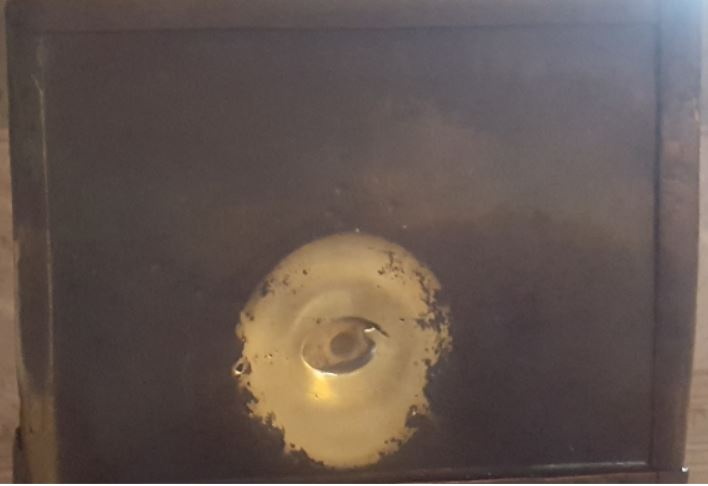
Upper Gallery
There are also worth seeing parts on the upper gallery which is closed as of today, unfortunately. There is a marble door which passes to the private section and you will see some mosaics there. Some windows have great views where you can see the Blue Mosque as well.

Hagia Sophia Istanbul- Mosaic Art (after conversion)
We will not tell you the exact locations. So, let’s explore where they are 🙂 Please also note that these figures are permanently or temporarily closed due to conversion into the mosque which is necessary for praying.
Emperor Leon VI
This mosaic represents emperor Leon VI of the Byzantine Empire. Jesus sits and there is a bible on his left hand saying “May peace be with you. I am the divine light.” On the right-hand side, the medallion has angel Gabriel and on the left-hand side, the medallion has Mother Mary figure.
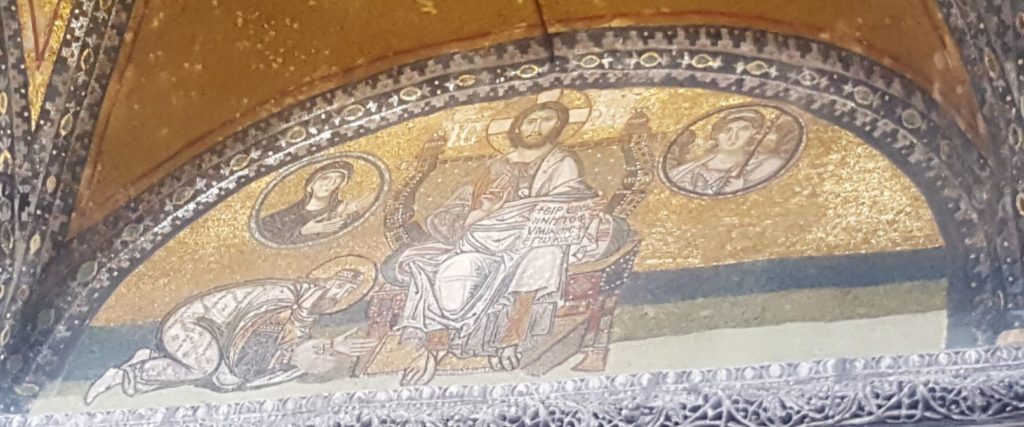
In this mosaic, Leon VI is praying because he wants to marry for the fourth time which is against church decision. He wanted to marry for the fourth time to have a son because his previous three wives had not given him a son (there is a rumor about his second wife had given him a son but he just died after the birth)
Dome- angel figures
There are four angel figures on the gigantic dome. People believed that the angels which have one head and six wings (seraphim angels) protect the Lord’s throne in heaven. Additionally, in the Ottoman period, they cover the faces of these symbols by star-shaped metals.
The Virgin Mary and the Child- Jesus
Semi apse contains this mosaic. In this mosaic, Virgin Mary seats on a throne and holding child Jesus. Moreover, this mosaic dates back to the 9th century.

Deisis Composition
This is the start of the renaissance of Eastern Rome painting. In the middle, Pantocrator Jesus, on the left Ioannes Prodromos (John the Baptist) and on the left Virgin Mary stand. Furthermore, in this mosaic, John the Baptist and Virgin Mary request mercy for the prayers during doomsday.
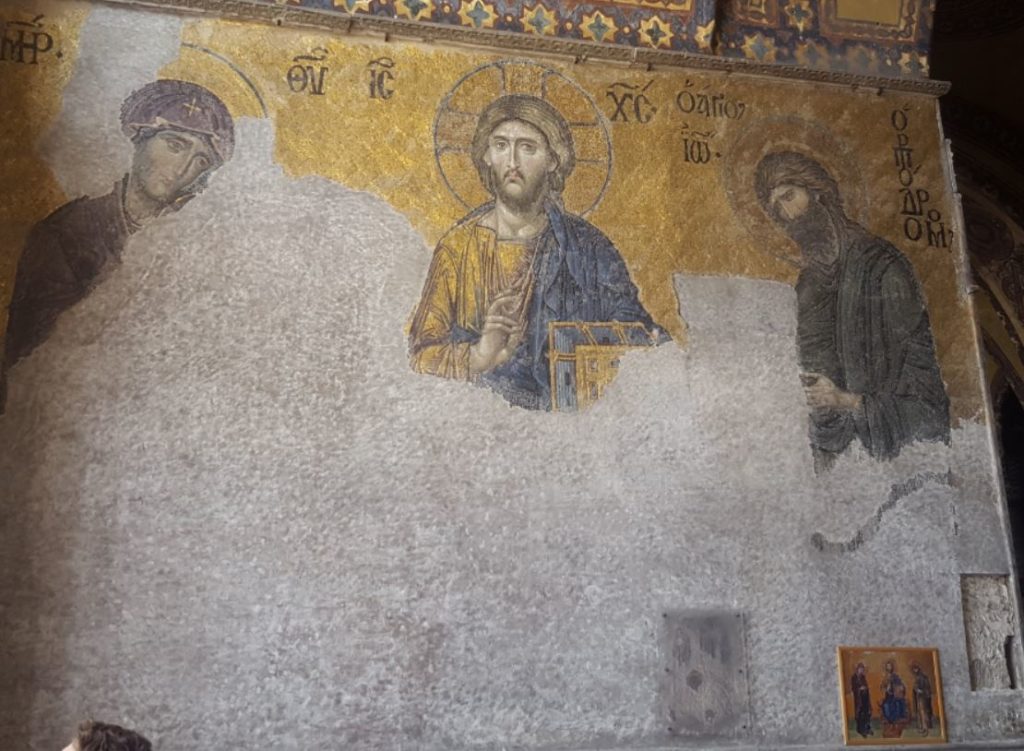
Komnenos and Zoe Mosaics
You will see these two mosaics next to each other which date back to the 11th and 12th centuries.
Virgin Mary is standing in the middle with Jesus Christ. Also, the other two are Emperor II. Ioannes Komnenos and his wife Eirene. In conclusion, the mosaic explains the donations made by the family for the Hagia Sophia’s restorations.
Similar to Komnenos mosaic, Emperor IX. Konstantinos Monomakhos (1042-1055) and Empress Zoe are placed in the mosaic board with Jesus Christ. And this one also symbolizes the donations made by the family for the Hagia Sophia’s restorations.
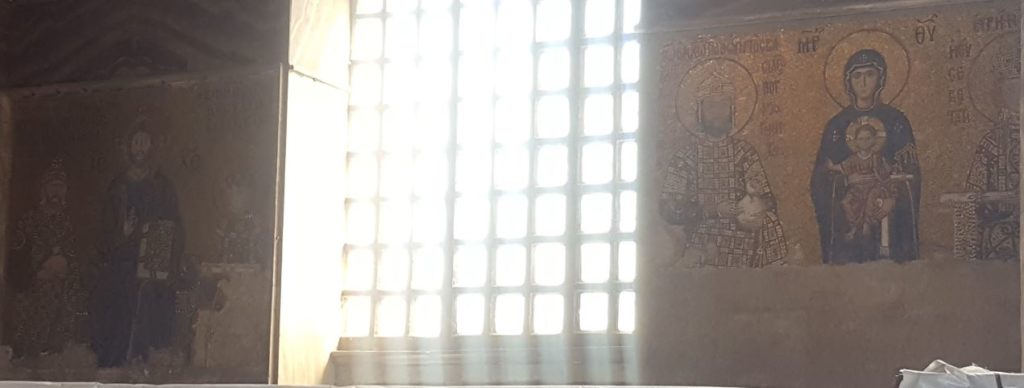
Also, you can see more mosaics such as
How Big is Hagia Sophia?
Hagia Sophia is a very big place. The base is not a perfect square and it has 74.67 x 69.80 meters (245 x 229 feet) dimensions. Moreover, the dome’s diameter is not a perfect one (it can’t be, right? :)) and it varies for some locations, but we can say it is between 31.9 – 30.9 meters (104.5 – 101.3 feet), and it is also 55.6 meters (182.4 feet) high from the floor.
Hagia Sophia Facts
Some stones belonging to Second Hagia Sophia are being presented at the entrance. Additionally, the stone which has a glyph with lambs represents apostles- each of the twelve chief disciples of Jesus Christ.
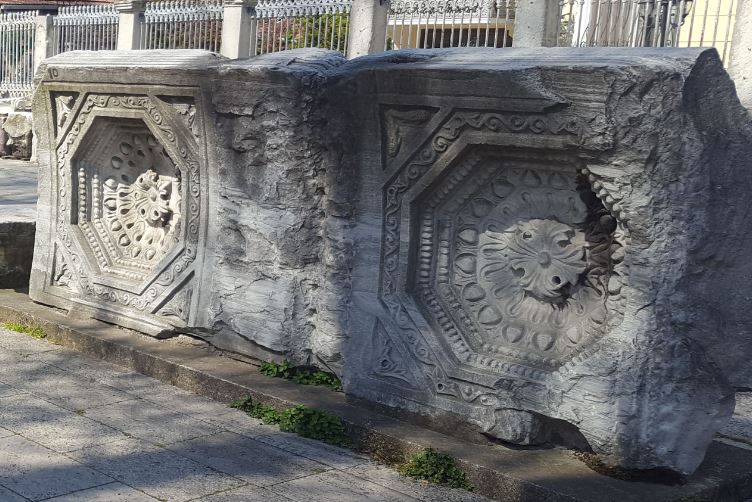
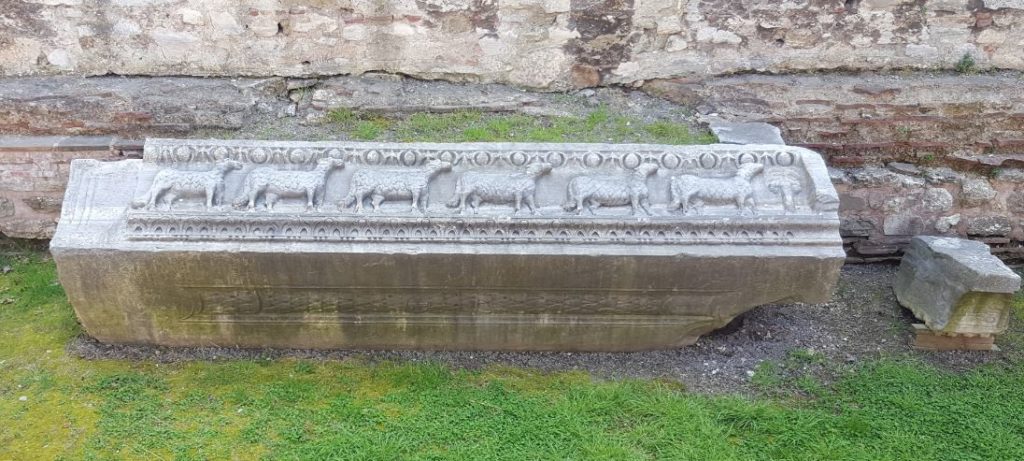
During the Byzantine period, church councils used the Hagia Sophia’s upper galleries. Also, during the Ottoman period, women used the upper galleries for praying.
Enrico Dandolo- the commander of Latin forces during the Fourth Crusade was buried in Hagia Sophia. Additionally, this crusade definitely increased the tension between Orthodox and Catholic sects. At that time, some relics removed from the cathedral and there were some severe damages by the Romans.
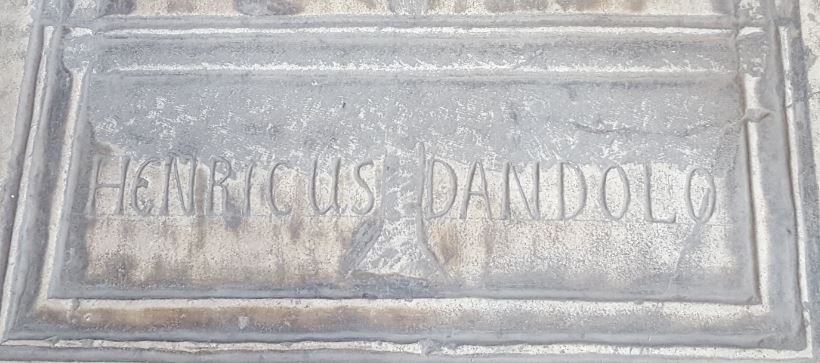
Hagia Sophia Underground Tunnels
Based on the limited amount of studies up-to-date completed by several researchers, they revealed some secrets of the Hagia Sophia underground tunnels and cisterns.
Basically, these studies began in the 1930s, however, stopped due to the Second World War. After a while, they started again, but the water under the Hagia Sophia was another problem.
A group of researchers deeply investigated the cisterns, wells, and tunnels in recent history. Additionally, the documentary producer who also influenced Dan Brown’s Inferno book investigated the underground.
They found out many interesting things. Topkapi Palace and the Basilica Cistern were connected by two tunnels. The explored cistern has been used for water storage. Under the ground, the researchers explored conduits. Also, they found some graves. The tunnels under Hagia Sophia were reaching to Crypto rooms. [9]
The Hippodrome
The Hippodrome which was in the Sultanahmet region was constructed in the 2nd and 3rd centuries. However, there is not much evidence due to several damages mostly during the fourth crusades. The gladiator fights and horseraces took place in the Hippodrome. Additionally, around 30,000 people had been killed in the Hippodrome during the rebellion in the Justinian period which also had caused the second Hagia Sophia’s collapse. Under the Hagia Sophia, the researchers found out some pieces of evidence about the hippodrome such as stables and graves.
It looks like there are still some secrets under the Hagia Sophia Istanbul :).
Is Hagia Sophia And Blue Mosque the Same?
We are lucky that these two fantastic figures in Istanbul are different. Blue mosque is also called “Sultan Ahmed Mosque”. Sultan Ahmed constructed the mosque between 1609 and 1616. Furthermore, this mosque has an interesting story. The mosque was constructed with six minarets which were equal to Prophet’s Mosque in Mecca. At that time, there were big discussions because of this minaret count equality, and Sultan Ahmed ordered the addition of one more minaret to the mosque in Mecca.
Where is Hagia Sophia?
Hagia Sophia is in Istanbul, Turkey. It is located
How to Reach Hagia Sophia- Transportation Guide
How to Go to Hagia Sophia from Topkapi Palace?
It is very close, just 3-4 minutes of walking.
How to Go to Hagia Sophia from Blue Mosque?
It is very close, just 5 minutes of walking. You will definitely notice the Blue Mosque since it is the opposite of Hagia Sophia.
How to Go to Hagia Sophia from Taksim?
Unfortunately, traffic jams can be frustrating in Istanbul. So, we first recommend you to use the railways to reach your destinations.
- By taxi, you can go there in 20 minutes from Taksim square. It is around 5
km - If you like walking, this can take an hour to reach Hagia Sophia. This can be very tiring, however, there is a great route. You can check Beyoglu, Galata Tower, Karakoy, Eminonu, Spice Bazaar, Grand Bazaar, and finally reach Hagia Sophia. What do you think? 🙂
- Okay, here is the best option. You can catch F1 (Taksim-Kabatas funicular) and then transfer to T1 (Bagcilar Kabatas tramway line). You can get off the train at Sultanahmet stop. Just 3 minutes walking from Sultanahmet to reach the Hagia Sophia. If you want you can walk to Kabatas by walking and then skip F1- the funicular. It is just 15 minutes of walking.
How to Go to Hagia Sophia from Dolmabahce Palace?
This one is easy. You can catch the M1 from Kabatas.
How to Go to Hagia Sophia from Kadikoy [10]?
The most feasible two options are as follows.
- You can go to Eminonu by city line or Turyol ferries. And then, you can catch T1 or walk from Eminonu.
- You can also go by M4 metro from Kadikoy to Ayrilik Cesmesi and transfer to Marmaray and go to Sirkeci. It is just 10-15 minutes after Sirkeci.
How to Go to Hagia Sophia from Ataturk airport?
Ataturk airport is not active anymore for commercial flights. The transition period is completed. However, we still would like to keep these options whether you need it. The distance from this airport to Hagia Sophia Sophia Istanbul is around 20 km or 32 miles. Especially, what we said above (recommending railways) can be challenging for some situations with huge suitcases.
- The best option is definitely to catch a taxi.
- The second option would be to go to Taksim by Havabus and then you can catch a taxi or follow the guidelines above.
- The other options are challenging. One of them is to catch M1, walk a little bit, and then catch T1. The second one is to catch M1 again and then transfer to Marmaray and then walk around 10 minutes.
How to Go to Hagia Sophia from the new Istanbul airport?
New Istanbul Airport is pretty far away from the city center. You can catch the bus Yenikapi-Sirkeci from the new airport. And then, you can get off from the bus at the nearest station to Hagia Sophia. Actually, since it is above 50 km, the taxi option might be costly.
Opening and Closing Days/Hours (after conversion)
For comparison purposes, we keep the old info as well.
Old Info before Mosque
There are specific hours for winter-between 1st November-15th April and summer- 15th April-31st October. The museum is open from 9 a.m to 5 p.m for winter and 9 a.m to 7 p.m for summer. Additionally, the museum is closed on Mondays, but this can be changed with further notice. The last entrance is one hour earlier than closure time.
The Hagia Sophia is also close for half a
Please check this official link before going to the museum. [7]
New Info after Mosque
Nobody can limit your visit since the mosques can not be closed. However, during the praying times, it is not allowed to check inside the mosque freely. So, you should watch out for praying times.
Ticket Price (after conversion)
For comparison purposes we keep the old info as well.
Old Info before Mosque
Based on 2020, the Hagia Sophia Istanbul ticket price for a single entry is 100 TL. As a piece of information, Turkish citizens can purchase a Museum Card which is 60 TL and can visit a lot of museums with this card for free.
Additionally, Museum Pass for Turkey is 550 TL for 15 days and Museum Pass for Istanbul is 325 TL for 5 days.
New Info after Mosque
Nobody can charge you when entering a mosque. This means that there is no entrance fee or ticket and it is totally free!
When to Visit Hagia Sophia Istanbul- Best Season?
Regardless of the seasons, you can come and visit the Hagia Sophia museum. However, waiting in line under heavy rain or snow might not good to hear. Our preference is Spring and Fall to visit Istanbul. Check out this post to learn more about the seasonal info of Istanbul [12].
Why Visit Hagia Sophia Istanbul?
We know that Istanbul has many options to do. When we want to go to different cities or countries, our first aim is “to eat like a local, to drink like a local, in conclusion, to behave like a local”. But not visiting Hagia Sophia means to skip Eiffel Tower in Paris during a visit. Believe that we are not exaggerating. So, as a tourist, you should definitely visit and feel the combination of the Orthodox sect and the Muslim religion. This place is at the top of “must-see places” in Istanbul.
Visitors per Year
Hagia Sophia is one of the most visited places in Istanbul. You can see the official yearly visitors of the Hagia Sophia starting from 2007 till 2016.

Shaping your Route around Hagia Sophia
So, this one is pretty easy. The route is very clear. If you have one day our around Hagia Sophia, the list is as follows.
- Start with Topkapi Palace
- Move to Hagia Sophia
- Visit Basilica Cistern, obelisk, etc. which is close to the Blue Mosque.
- Finish with Blue Mosque and Sultanahmet Square.
We suggest you visit the Hagia Sophia before the Blue Mosque where you can find some references in Blue Mosque from the Hagia Sophia. But you can try any other combination too.
Conclusion (after conversion)
We assume you found out great information about the structure, the reasons for construction, why and when the cathedral became a mosque, and what is inside of the mosque.
As we already mentioned, Hagia Sophia Istanbul is definitely a must-see place. Additionally, its location is fantastic where you can quickly visit Topkapi Palace, Blue Mosque, and Basilica Cistern, obelisks without losing time with transportation.
References
- http://www.hurriyetdailynews.com/earthquakes-pose-threat-to-historic-monuments-in-istanbul-73854
- https://world.new7wonders.com/wonders/
- https://www.britannica.com/topic/Hagia-Sophia
- https://www.istanbulfantasy.com/istanbul-history/
- https://www.history.com/topics/ancient-greece/hagia-sophia
- https://www.pbs.org/wgbh/buildingbig/wonder/structure/hagia_sophia.html
- https://muze.gen.tr/muze-detay/ayasofya
- http://www.kultur.gov.tr/EN-113941/istanbul—hagia-sophia-museum.html
- http://culturecityistanbul.blogspot.com/2017/09/hagia-sophia-museum-underground-tunnels.html
- https://www.istanbulfantasy.com/kadikoy-and-moda-the-ultimate-guide/
- http://www.hava.ist/en/
- https://www.istanbulfantasy.com/best-time-to-visit-istanbul/
Note: This post has been updated in January, 2021.